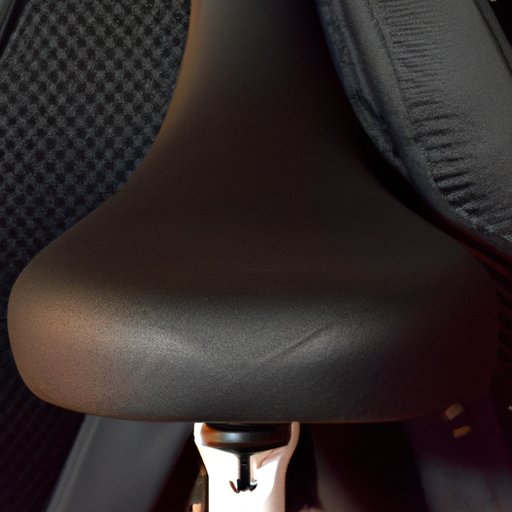Introduction
Having an uncomfortable bike seat can make cycling less enjoyable, leading to decreased motivation and even pain while riding. Fortunately, there are many ways to adjust your bike seat to ensure it fits your body properly. In this article, we’ll discuss how to adjust a bike seat, including measuring leg length, setting up the saddle angle and finding the right height for your bike seat.
Step-by-Step Guide to Adjusting Your Bike Seat
Adjusting your bike seat doesn’t have to be a difficult task. Here’s a step-by-step guide to help you get started:
Preparing the Bike
Before making any adjustments, make sure your bike is in a secure position. If possible, use a repair stand. If not, lean the bike against a wall or other sturdy object. Make sure the brakes are engaged so the bike won’t move during the adjustment process.
Adjusting the Height of the Seat
The first step to adjusting your bike seat is to adjust the height. The correct height will depend on your leg length; however, a good rule of thumb is to set the seat height so that your knee is slightly bent when the pedal is at its lowest point. To adjust the seat height, loosen the seat post clamp and move the seat up or down until it is at the desired height.
Setting Up the Saddle Angle
Once the seat height is adjusted, you can then adjust the angle of the saddle. The correct angle will depend on your riding style and preference, but generally speaking, the saddle should be parallel to the ground. To adjust the angle, loosen the seat post clamp and rotate the saddle until it is at the desired angle.

How to Find the Right Height for Your Bike Seat
Finding the right height for your bike seat is essential for achieving a comfortable ride. Here are some tips to help you find the right height:
Measuring Leg Length
To determine the correct seat height, you’ll need to measure your inseam (the distance from your crotch to the ground). Once you have this measurement, you can use the following formula to calculate the ideal seat height: seat height = inseam x 0.883.
Adjusting the Seat Height
Once you’ve calculated the ideal seat height, you can adjust the seat accordingly. First, loosen the seat post clamp and move the seat up or down until it is at the desired height. Then, tighten the seat post clamp to ensure the seat is securely in place.

Tips for Setting Up Your Bike Seat for Optimal Comfort
In addition to adjusting the height and angle of your bike seat, there are several other factors to consider when setting up your bike seat for optimal comfort. Here are some tips to keep in mind:
Position of the Handlebars
The position of the handlebars can affect your riding posture, which can in turn affect the comfort of your ride. Make sure the handlebars are at a comfortable height and position that allows you to maintain a straight back while riding.
Types of Bicycle Seats
Different types of bicycle seats can provide different levels of comfort. For example, some seats are designed specifically for long-distance rides, while others are better suited for short rides. Consider your riding needs and preferences when choosing a bike seat.
Padding and Cushioning
Adding padding and cushioning to your bike seat can make a big difference in terms of comfort. Look for a seat with adequate padding and cushioning to reduce pressure points and make your ride more comfortable.
A Comprehensive Guide to Adjusting Your Bike Seat
Now that you know how to measure leg length, adjust the height of the seat and set up the saddle angle, it’s time to put all of these steps together into a comprehensive guide to adjusting your bike seat. Here’s what you need to do:
Removing the Old Seat
Before installing a new seat, you’ll need to remove the old one. To do this, loosen the seat post clamp and slide the seat off of the post. Be sure to save the seat post clamp so you can reattach the new seat.
Installing the New Seat
Once the old seat is removed, you can install the new seat. Slide the seat onto the seat post and tighten the seat post clamp to secure it in place. Make sure the seat is level and aligned correctly before tightening the clamp.
Final Adjustments
Once the new seat is installed, you can make final adjustments to ensure the seat is comfortable. Adjust the height and angle of the seat as needed, and check that the handlebars are at a comfortable height and position.

The Basics of Adjusting a Bicycle Seat
Adjusting a bicycle seat may seem intimidating at first, but it’s actually quite simple. Here are the basics of adjusting a bicycle seat:
Making Sure the Seat is Level
The first step is to make sure the seat is level. To do this, use a bubble level or a carpenter’s level to check that the seat is even from side to side.
Adjusting the Forward-Back Position
Once the seat is level, you can adjust the forward-back position. Move the seat forward or backward until it is in the desired position. Make sure the seat is secure and won’t move during your ride.
Tightening the Seat Post Clamp
Finally, tighten the seat post clamp to ensure the seat is securely in place. Be sure to use the appropriate tools for the job – typically either a wrench or an Allen key.
Conclusion
Adjusting your bike seat is an important step in ensuring a comfortable and enjoyable ride. With the right tools and knowledge, you can easily adjust the height and angle of your bike seat to fit your body and riding style. Remember to measure your leg length, adjust the height of the seat and set up the saddle angle for optimal comfort.


